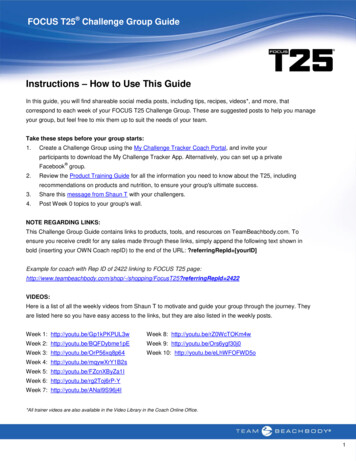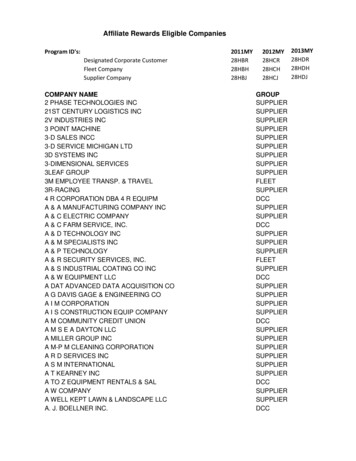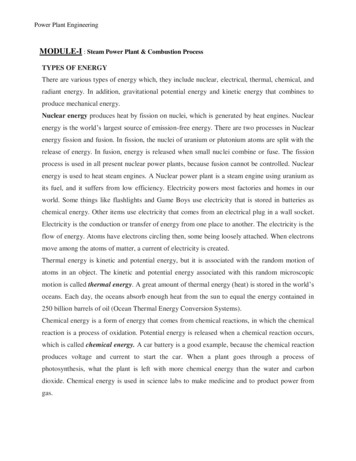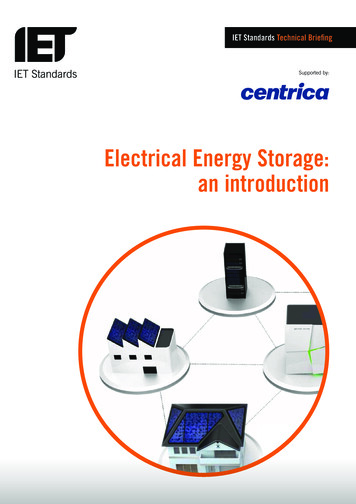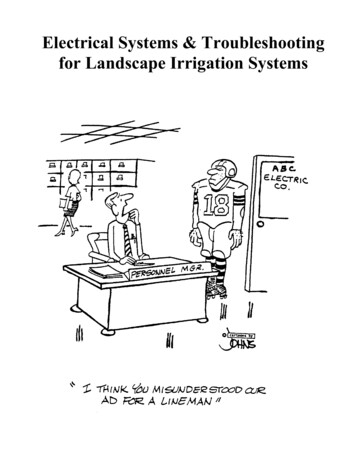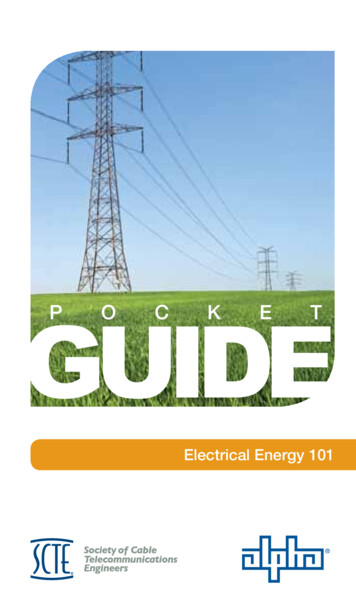
Transcription
GUIDEPOCKETElectrical Energy 101
Providing technical leadershipfor the telecommunicationsindustry and serving itsmembers through professionaldevelopment, standards,certification and information.Join today - www.scte.org
AlphaPocket GuideElectrical Energy 101
Copyright 2012 Alpha Technologies Inc.All Rights Reserved. Alpha is a registered trademark of AlphaTechnologies. Reproduction in any manner whatsoever without theexpress written permission of Alpha is strictly forbidden. For moreinformation, contact Alpha.TrademarksThe capabilities, system requirements and/or compatibility withthird-party products described herein are subject to change withoutnotice. Alpha, the Alpha Logo,, CableUPS are all trademarksof Alpha Technologies Inc. All other trade names and productnames herein, including those related to third party products andservices are trademarks of their respective owners. Information ontrademarks used in this reference book are listed below. ANSI is aregistered trademark of the American Standards Institute. NEMA is a registered trademark of the National Electric ManufacturersAssociation. The National Electric Code is a registered trademark.NFPA 70 , NFPA 78 is a registered trademark of the National FireProtection Association, Inc.Contents and specifications in this reference book are subjectto change without notice. Alpha reserves the right to change thecontent as circumstances may warrant.
Alpha Technologies Inc., a member of The Alpha Group,provides the communications industry with the most reliable,technologically advanced and cost-effective powering solutionsavailable. Alpha offers innovative powering solutions thatare designed for the future, built to support expansion andprovide unlimited opportunity. Widely used in cable television,communications and data networks worldwide, Alpha productshave earned a reputation for reliability and performance. Alphaprovides a full line of power products including: standby, nonstandby and uninterruptible power supplies, surge suppressors,enclosures, batteries and powering accessories.Contacting AlphaFor additional information on Alpha products, services or repairs,please email alpha@alpha.com or call 360 647 2360.
IntroductionThis pocket guide is dividedinto six chapters. The rightpages of each chapter aremarked with a tab that linesup with the thumb index tabson the right of this page.You can quickly find thefirst page of each chapterby flipping through the pagesof this Pocket Guide or byusing the Table of Contentswhich follows.Fundamentals1Sources of Energy2Energy Measurement3Physical Infrastructure4Financial, Codes,Laws & Standards5General ReferenceInformation6DisclaimerAll information in this PocketGuide is based on thelatest industry and productinformation available at thetime of printing. Alpha reservesthe right to make changesat any time without notice.No part of this publicationmay be reproduced, stored,or transmitted, in any formby any means—electronic,mechanical, photocopying,or otherwise—without priorwritten consent of Alpha.
Table of Contents Fundamentals15-30What is Electrical Power?.16What is a Watt?.16What is a kW (kilowatt)?.16What are kWhrs or kWh?.16What is a MW (megawatt)?.16What is a MWh?.16What is Electric Current?.16What is an Electrical Circuit?.17What is an Ampere (aka Amp)?.17What is Electromotive Force?.17What is a Volt?.17What is a kV (kilovolt)?.17What is an Ohm?.18What is Ohm’s Law?.18What is a Conductor?.19What is Electrical Resistance?.19What is Resistance?.19What is a Resistor?.20What is Capacitance?.20What is a Capacitor?.20What is Inductance?.20What is an Inductor?.20What is a Henry?.20What is a Diode?.20What is an LED?.21Where does electrical power come from?Where does it go?.21What is Load?.21What is Load Diversity?.21What is Load Factor?.22What is Load Management?.22What is Partial Load?.22What is Distribution?.22
Table of ContentsWhat is Distribution Service?.22What is DC (Direct Current) Power?.23What is AC (Alternating Current) Power?.23What is Frequency?.23What is Hertz?.24What is a Cycle?.24What is a Sine Wave?.24What is a Transformer?.24What is a Transistor?.25What is Shielding?.25What is Polarity?.25What is Grounding?.26Why is Grounding important?.26What is a “Disconnect?”.26What is Bonding?.27What is a Surge?.27What is Real, Reactive and Apparent Power?.27What is Volt Ampere (VA)?.28What is Power Factor?.28What is Lead/Lag?.28What is Distortion (PF)?.29What is Efficiency?.29What is the difference between PowerConsumption and Power Dissipation?.29What is a Constant Power Source?.29What is a Constant Power Load?.30What is a Blower Door Test?.30
Table of Contents Sources of Energy31-40What is Electricity?.32What is an Electricity Supply Service?.32What is a Battery?.32What is Chemical Energy?.32What are Ahrs?.32What is Battery Capacity?.33What are Battery Types?.33What is a Generator?.33What is a Power Plant?.33What is a Power Supply?.33What is a CableUPS ?.34What is Fuel?.34What is Generation/Supply?.34What is a Fuel Cell?.34What are Renewable Power Sources?.35What are Fossil Fuel Sources?.35What is Wind Power?.36What is Daylighting?.36What is Daylighting Control?.36What is Photovoltaic Power?.36What is the Grid?.36What is a Smart Grid?.36What is a Brownout?.37What is a Blackout?.37What is Lightning Surge?.37What causes a Power Failure (Blackout)?.37What is Single-Phase vs. Three-Phase Power?.38What is Demand Bid?.39What is Demand Charge?.39What is Demand Response?.39What is Demand-side Management?.39What is Peak Demand?.39What is Co-generation?.40What is Transmission?.40
Table of Contents Energy Measurement41-45What is a Meter?.42What is a Smart Meter?.42What is a TOU Meter?.42What are TOU Rates?.42What is an Automatic Meter Reading System?.42What is a Meter Rate Multiplier?.43What is BTU?.43What is a Joule?.43What is a Calorie?.43What is R Value?.43What is Electrical Safety?.43What is a Lumen?.44What is a Ton of Cooling?.44What is Temperature?.44What is a Thermographic Scan?.44What is a Thermostat?.44What is Thermostat Setback?.44What is UA?.44What is the SI Unit Scale?.45What are Electrical Formulas?.45
Table of Contents Physical Infrastructure47-52What is a Circuit Breaker?.48What is a Fuse?.48What is a Trip Curve?.48What is a “Main”?.49What is a Service Entrance?.49What is a Branch Circuit?.49What is a Transient Surge Suppressor?.49What is MOV?.49What is Conduit?.49What is Neutral?.49What is Ventilation?.50What is HVAC?.50What is a VAV System?.50What is an Air Conditioner?.50What is Heating Seasonal Performance Factor?.50What is Recool?.50What is a Fan Coil?.50What is Cable Loss?.51What are Losses?.51What are the wire components of an AC outlet?.51What is a Charge Controller?.51What is a Ferro Transformer?.51What is a Transfer Switch?.52What is an Inverter?.52What is PFT Air Infiltration Measurement?.52What is a CFL?.52What is Building Envelope?.52
Table of Contents Financial, Codes, Laws & Standards53-59How is Electricity Billed?.54What is Monthly Energy Usage?.54What is the LDC?.54What is a Municipal Utility?.54What is a Tariff?.54What is Demand Billing?.54What is a Rate Schedule?.55What is Real-time Pricing?.55What is a Rate Structure?.55What are the components that makeup energy costs?.55What is an Energy Audit?.55What is an Upgrade?.55What is Price to Compare?.55What are Cooperatives?.56What organization regulates powerlaws in the United States?.56Who is the international powerstandards developer?.56What is Energy Benchmarking?.56What is Energy Charge?.56What is Energy Consumption?.56What are Renewable Energy Tax Credits?.56What is Net-metering?.57What is DOE?.57What is the EPA?.57What is LEED?.57What are Energy Laws, Codes and Standards?.58What is the Law of Conservation of Energy?.58What are the types of AC plugs according to NationalElectric Manufactures Association (NEMA)?.58What are Plug Standards (IEC)?.58What is Power Sustainability?.59What is NEC?.59
Table of Contents General Reference Information61-74Power Conversion Factors.62Symbols for Power Systems and Facilities.63Conversion Factors.64Celsius to Fahrenheit Conversions.67U.S. Weights and Measurements.68Metric System.70Measurement of Fuels.73Metal Properties. 74
Fundamentals1Fundamentals15
FundamentalsWhat is Electrical Power?The time rate at which electrical energy is emitted, transferred,or received. In the USA, electrical power is typically expressedin watts.What is a Watt?The watt is a unit of measure for electrical power. Wattage is theproduct of the electrical force (voltage) and the electrical current(amperes) in an electrical circuit.What is a kW (kilowatt)?One thousand watts (1,000). A form of measurement for thequantity of electricity needed to control given equipment.What are kWhrs or kWh?Kilowatt hours. This is the time-rate measurement for theconsumption of energy. If a device consumes 1000 Wattsof power for 1 hour, it has consumed 1 kilowatt hour (kWh).Additionally, 500 Watts for 2 hours is also 1 kWh.What is a MW (megawatt)?One-thousand kilowatts (1,000 kW) or one million(1,000,000) watts.What is a MWh?(Megawatt Hour) One thousand kilowatt hours.What is Electric Current?A flow of electricity through a conductor.16
Fundamentals1What is an Electrical Circuit?A circuit is a closed path through which an electric current flows.It is an arrangement of interconnected electronic componentsthat can perform specific functions upon application of propervoltages and signals. If you think of your home, typically eachroom is serviced by a dedicated electrical circuit, protected bya circuit breaker in the main service panel to allow you to canturn sections of your home ON or OFF without affecting theentire house.What is an Ampere (aka Amp)?A unit of measure for the flow of electrons (current) within anelectrical wire. It is analogous to the flow of water (gallons/sec)in a water pipe. Common electrical circuits used in homes aretypically rated at 15 or 20 Amps.What is Electromotive Force?The voltage generated by a battery or by magnetic force. Refersto the potential, or energy per unit of charge.What is a Volt?A unit of measure for electrical potential difference orelectromotive force in an electrical circuit. It is analogous tothe amount of water pressure (pounds per square inch) in awater line. Electrical systems of most US houses and officeshave 120 volts.What is a kV (kilovolt)?One thousand (1,000) volts. Electrical lines in housing areasusually are 12kV (12,000 volts).17
FundamentalsWhat is an Ohm?A unit of measure for the resistance in an electrical circuit.What is Ohm’s Law?A law and mathematical formula stating the current in an electriccircuit is inversely proportional to the resistance of the circuitand is directly proportional to the electromotive force in thecircuit. Ohm’s law applies strictly to linear constant-currentcircuits.(P) Power, measured in watts.(E) Voltage, measured in volts(I) Current, measured in amperes or amps(R) Resistance, measured in ohmsE2RRxIMSPEIOHRPSPEPxREIAMPRPISLTExIVOWATTSR x I2ERPI2E2PThere are three basic Ohm’s Law formulas:I E/RAmperes Volts/OhmsR E/IOhms Volts/AmperesE I*RVolts Amperes*Ohms18VR
Fundamentals1What is a Conductor?A conductor (aka “a wire”) is a substance or body that allows acurrent of electricity to pass continuously along it. Conductorsmay be solid or stranded, that is, built up by an assembly ofsmaller solid conductors. For example, metal wires and cablesare frequently used for carrying electric current.AmericanWire GaugemmArea Cir.Mils.Current Rating Amps(for ventilated cablerack 8523566,36011515083,690130105,6001500What is Electrical Resistance?The degree to which an object opposes the flow of electricalcurrent. The result of resistance is that the voltage of a circuitwill decrease as the current flows through the circuit. This issimilar to the way water flow decreases due to friction as itpasses through a hose.What is Resistance?The ability of all conductors of electricity to defy the flow ofcurrent, turning some of it into heat. Resistance relies on thecross section of the conductor (the smaller the cross section,the superior the resistance) and its temperature (the hotter thecross section, the more the resistance).19
FundamentalsWhat is a Resistor?A electrical component that implements resistance as a circuitelement. Resistance is the opposition to the passage of currentthrough a conductor. Measured in Ohms.What is Capacitance?The ability of an object to store an electrical charge.Measured in Farads.What is a Capacitor?A device with the primary purpose of introducing capacitanceinto an electric current. It is an electronic component, consistingof two or more isolated plates, used to temporarily storeelectrical energy. It is similar to a reservoir storing the springrunoff for use later in the summer months.What is Inductance?The ability of an object to resist a change in electrical current bygenerating an electromagnetic field. Measured in Henrys.What is an Inductor?An electrical component that stores energy in its magneticfield. An Inductor is typically made of a wire or other conductorwound into a coil, to increase the magnetic field.What is a Henry?The inductance of a closed circuit in which an electromotiveforce of one volt is produced when the electric current in thecircuit varies uniformly at a rate of one ampere per second.What is a Diode?A diode is a semiconductor device. Since electric currentpasses through it in only one direction, the diode is ideal for useas a rectifier (AC in one side, DC out on the other).20
Fundamentals1What is an LED?Light-Emitting Diodes are used as indicator lamps in manydevices, especially for lighting. LED’s are based on thesemiconductor diode and present many advantages overincandescent lights including lower energy consumption andlonger life span.Where does electrical power come from? Where does it go?Electrical power is typically generated by converting other formsof energy into electricity. For example, the energy in coal, naturalgas and nuclear reactors are all used to produce steam that isused to drive generators that produce electricity. Electricityis delivered to homes and businesses over transmissionwires often referred to as “The Grid.” The potential for workcontained in the electricity delivered to our homes andbusinesses is then consumed by a wide variety of electricaldevices to perform work. For example, a space heater willconvert 1000 Watts of electrical energy into heat to raise thetemperature of a cold room.What is Load?The amount of electric power supplied to meet one or more finaluser’s needs. Also refers to an end-use device or an end-usecustomer that uses power.What is Load Diversity?A situation that subsists when the peak demands of severalelectric customers happen at dissimilar times. This is the goalof “load molding” strategies, which curbs the total capacityrequirements of a utility.21
FundamentalsWhat is Load Factor?The difference between the amount of electricity consumed bya customer during a specified time and the amount that wouldhave been used if the usage had stayed at the consumershighest demand level during the whole time. The term is alsoused to mean the percentage of capacity of an energy facility(such as power plant or gas pipeline) that is employed in aspecific time period.What is Load Management?Steps taken to decrease power demand at highest loadtimes or to move some of it to off-peak times. This mayrefer to peak hours, peak days or peak seasons. The maindisruption to electric peaks is air-conditioning usage, whichis therefore a major target for load management labors. Loadmanagement may be pursued by convincing consumers tochange behavior or by using equipment that regulates someelectric consumption.What is Partial Load?An electrical demand that only uses a fraction of the availableelectrical power.What is Distribution?Electricity delivered to a location through low voltagedistribution lines.What is Distribution Service?The delivery of electricity directly to a home or business.22
Fundamentals1What is DC (Direct Current) Power?An electric current that flows in only one direction. Direct currentis produced by sources such as batteries and solar cells.What is AC (Alternating Current) Power?An electrical current that reverses direction in a circuit at regularintervals. Alternating current is the type of electricity producedand delivered by the utility (power company) to your wall plug.Electrical power delivered in the USA alternates current at afrequency of 60 cycles per second (Hertz). Utilities deliver ACpower instead of DC power because transformers can be usedto easily convert the voltage from one circuit to another. Utilitiestypically deliver electricity over long distances from power plantsto neighborhoods using high voltage transmission lines of 1million volts or more. Transformers are then used to convert thehigh voltage lines to the 120V electrical power used in mosthomes and businesses.DIRECT CURRENT(DC)11ALTERNATING CURRENT(AC)11What is Frequency?Refers to the frequency of oscillations of alternating current (AC)in an electric power grid transmitted from a power plant to theend-user. Typically for AC power lines, the power frequency iseither 60 Hz (primarily North America) or 50 Hz (primarily Europeand other countries around the world).23
FundamentalsWhat is Hertz?Hertz is the international standard of measurement for frequencyin cycles per second.What is a Cycle?A series of events that are regularly repeated in the same order.When referring to electricity, it is the transition of voltage orcurrent from a starting point of zero to the positive peak, backthrough the zero to the negative peak, and returning to zero.What is a Sine Wave?A mathematical function that describes a smooth repetitiveoscillation. AC electricity alternates current direction based on a60Hz sine wave in the USA.SineWhat is a Transformer?An electrical device used to transfer an alternating currentor voltage from one electric circuit to another by means ofelectromagnetic induction. The simplest type of transformerconsists of two coils of wire, electrically insulated from oneanother and arranged so that a change in the current in onecoil (the primary) will produce a change in voltage in the other(the secondary).24
Fundamentals1What is a Transistor?A semiconductor device used to amplify and switch electronicsignals and current. It is composed of semiconductor materialwith at least three terminals for connection to an external circuit.A voltage or current applied to one pair of the transistor’sterminals changes the current flowing through another pair ofterminals. Consider a dimming light switch where it is able to beon, off or at some point in between.What is Shielding?The process of applying a conducting barrier between apotentially disturbing noise source and electronic circuitry.Shielding is used to protect cables (data and power) andelectronic circuits. Shielding may be accomplished by the use ofmetal barriers, enclosures or wrappings around source circuitsand receiving circuits.What is Polarity?Polarity (Positive and negative) is present in every electricalcircuit, with Electrons flowing from the negative pole to thepositive pole. In a direct current (DC) circuit, one pole is alwaysnegative, the other pole is always positive and the electronsflow in one direction only. In an alternating current (AC) circuit,the two poles alternate between negative and positive and thedirection of the electron flow reverses.25
FundamentalsWhat is Grounding?Generally used to describe the common connection in anelectrical or electronic circuit (almost always ultimately routedto the earth). In North America, the standard color for groundis GREEN.Sensitive electronic systems must be solidly grounded, i.e,directly connected with earth as required by either the ANSI/NFPA-70 or ANSA/NFPA-78, or both. Grounding systemsdesigned for a sensitive electronic equipment facility canbe conceptualized as having distinct, solidly interconnectedfunctional subsystems.The following diagram is an example of a grounding methodfor a standard enclosure. The grounding method for aparticular site also depends on soil type, available space,local codes, National Electric Code requirements and othersite-specific characteristics.Why is Grounding important?Grounding reduces the risk of serious electric shock fromcurrent leaking into uninsulated metal parts of an appliance,power tool or other electrical device. Grounding provides analternate low potential path for the energy in a circuit to flow.What is a “Disconnect?”A device used for control, circuit protection or safety thatremoves a circuit from a source of power. It takes an electricaldevice out of action by detaching it from a power supplythrough the operation of a disconnecting switch, circuit breakeror other switching device.26
Fundamentals1What is Bonding?Electrically connecting all exposed metallic, non-current carryingitems in a room or building as protection from electric shock.What is a Surge?A transient variation of current, voltage, or power flow in anelectric circuit or across an electric system. Surges are typicallycaused by lightning strikes, power outages, tripped circuitbreakers, short circuits, etc.What is Real, Reactive and Apparent Power?Real power is the portion of electricity that supplies energyto the load. Reactive power is the portion of electricity thatestablishes and sustains the electric and magnetic fields ofalternating-current equipment (must be supplied to mosttypes of magnetic equipment, such as motors andtransformers). Apparent power is the product of the voltage(volts) and the current (amperes), comprised of both activepower and reactive power.P real powerP P I2RE2RMeasured in units of WattsQ reactive powerQ I2XQ E2XMeasured in units of Volt-Amps-Reactive (VAR)S apparent powerS I2ZS E2XS 1EMeasured in units of Volt-Amps27
FundamentalsWhat is Volt Ampere (VA)?A measure of electrical power. In a DC circuit, one volt-ampereis equivalent to one watt. In an AC circui
What is Electrical Power? The time rate at which electrical energy is emitted, transferred, or received. In the USA, electrical power is typically expressed in watts. What is a Watt? The watt is a unit of measure for electrical power. Wattage is the product of the electrical force (voltage) and the electrical
